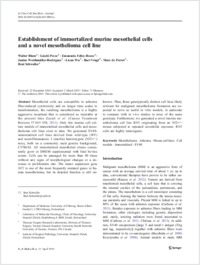Establishment of immortalized murine mesothelial cells and a novel mesothelioma cell line
- Blum, Walter Department of Medicine, University of Fribourg, Switzerland
- Pecze, László Department of Medicine, University of Fribourg, Switzerland
- Felley-Bosco, Emanuela Laboratory of Molecular Oncology, Clinic of Oncology, University Hospital Zürich, Switzerland
- Worthmüller-Rodriguez, Janine Department of Medicine, University of Fribourg, Switzerland
- Wu, Licun Thoracic Surgery Research Laboratories, Division of Thoracic Surgery, University of Toronto, Canada
- Vrugt, Bart Institute of Surgical Pathology, University Hospital Zürich, Switzerland
- Perrot, Marc de Thoracic Surgery Research Laboratories, Division of Thoracic Surgery, University of Toronto, Canada
- Schwaller, Beat Department of Medicine, University of Fribourg, Switzerland
-
2015
Published in:
- In Vitro Cellular & Developmental Biology - Animal. - 2015, p. 1–8
English
Mesothelial cells are susceptible to 10:38 05.06.2015asbestos fiber-induced cytotoxicity and on longer time scales to transformation; the resulting mesothelioma is a highly aggressive neoplasm that is considered as incurable at the present time Zucali et al. (Cancer Treatment Reviews 37:543–558, 2011). Only few murine cell culture models of immortalized mesothelial cells and mesothelioma cell lines exist to date. We generated SV40-immortalized cell lines derived from wild-type (WT) and neurofibromatosis 2 (merlin) heterozygote (Nf2+/−) mice, both on a commonly used genetic background, C57Bl/6J. All immortalized mesothelial clones consistently grow in DMEM supplemented with fetal bovine serum. Cells can be passaged for more than 40 times without any signs of morphological changes or a decrease in proliferation rate. The tumor suppressor gene NF2 is one of the most frequently mutated genes in human mesothelioma, but its detailed function is still unknown. Thus, these genotypically distinct cell lines likely relevant for malignant mesothelioma formation are expected to serve as useful in vitro models, in particular to compare with in vivo studies in mice of the same genotype. Furthermore, we generated a novel murine mesothelioma cell line RN5 originating from an Nf2+/− mouse subjected to repeated crocidolite exposure. RN5 cells are highly tumorigenic.
- Faculty
- Faculté des sciences et de médecine
- Department
- Département de Médecine
- Language
-
- English
- Classification
- Biological sciences
- License
- License undefined
- Identifiers
-
- RERO DOC 255676
- DOI 10.1007/s11626-015-9885-z
- DOI 10.1007/s11626-015-9885-z
- Persistent URL
- https://folia.unifr.ch/unifr/documents/304292
Other files
Statistics
Document views: 89
File downloads:
- sch_eim.pdf: 125
- sch_eim_err.txt: 34

